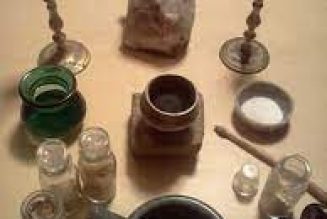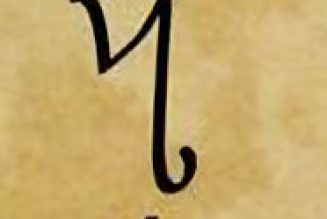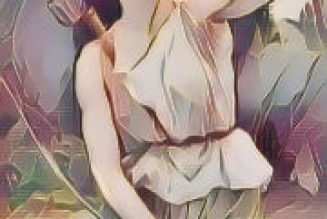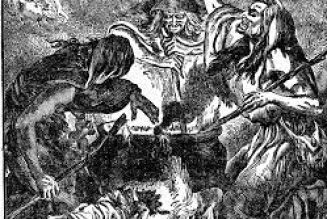The cat, especially the black cat, is a creature of witchcraft, in all popular belief.
No artist’s conception of a witch’s cottage of the olden time could possibly be complete without Baudrons or Grimalkin, sleek and purring by the fire, watching with glowing eyes over all that takes place.
The witch’s cat, however, did not have to be black in color.
In Macbeth, it is a brindled cat that mews significantly, and the name ‘Grimalkin’ means a grey cat.
Indeed, the whole royal feline race of cats have something about them which is magical and uncanny.
They probably inherit this quality from Ancient Egypt, where they were sacred beasts.
The Egyptian cat goddess Bast seems to have been a feline form of Isis.
Bubastis was her sacred city; and there and at other places in Egypt thousands of carefully mummified and reverently interred bodies of cats have been found.
The British Museum possesses a number of beautiful relics of the cat cult of Ancient Egypt; notably the hollow sarcophagi, or statues in the life-like forms of cats, inside which the mummified bodies of deceased pets were placed.
Cats have been known in Britain from early times.
The domesticated cat was brought from Ancient Egypt and introduced to Britain by the Romans.
A certain Welsh prince, Hywel, passed special laws for the protection of cats.
He was evidently a cat lover, but the cats depicted in old churches are usually of sinister aspect.
Feline demons carved in stone glare grotesquely at the worshipper, especially in some of our churches which date from the Norman period.
This is another instance of the gods of the old religion becoming the devils of the new.
A famous weird carving connected with witchcraft is the one in Lyons Cathedral, which depicts a naked witch holding up a cat by its back legs, as she rides upon a goat, which has formidable horns but a human face.
Her only garment, a cloak, streams behind her in the wind ; with one hand she clings to the goat’s horns, while she grasps the cat in the other.
Witches were often accused of changing themselves into cats for the purpose of molesting people, or for running swift-footed by night upon some uncanny errand.
The eat’s nocturnal habits, its moon-like eyes, and horrid midnight caterwauling, all contributed to its sinister reputation.
So also did the electric nature of its fur, from which visible sparks of static electricity can sometimes be stroked in a dark room.
The Devil was sometimes said to appear at the Sabbat in the form of a huge black cat.
One wonders whether this was a far-off reminiscence of ancient cat worship.
The pagan gods were sometimes believed to appear as animals.
Diana took the form of a cat, and Pan of a goat.
The deities of the witches were in fact aspects of Pan and Diana, the Horned God and the Moon Goddess; and the cat and the goat are the animals most associated with witchcraft, in popular legend and belief.
To this day, there are people who fear to have a black cat cross their path; though they probably do not realize the origin of this belief, namely that the animal might be a witch in cat form.
Others, however, regard the black cat as a symbol of good luck.
The old folk rhyme tells us : Whenever the cat of the house is black, The lasses of lovers will have no lack.
People wear black cat charms and brooches, and in the nineteen twenties and thirties there was quite a vogue for teapots in the form of black cats, as there is today for table-lamps in the same shape.
There are innumerable stories of cats being able to see things that are invisible to human eyes. Indeed, there is hardly a confirmed cat lover to be found, who cannot tell some anecdote of their pet having psychic or telepathic powers.
The writer has heard of two cases (one observed by her own mother) of cats which were capable of astral projection; that is, their forms were seen in one place when it was proved that their sleeping bodies were in another.
It has also been a matter of some observation, that cats definitely enjoy Spiritualist seances.
A Spiritualist once tried her best to exclude her cat from the room where seances were held because she believed that the cat ‘took the power’.
It is not quite clear what she meant by this, but the cat refused to accept this exclusion and would try every trick he knew (and cats know plenty) to slip into the room and take part in the sitting.
Alot of Spiritualists, however, accepted their eat’s desire to be present at seances; and this particular cat, a huge black neutered tom, would stalk majestically into the seance room and preside over the meeting.
Either of these cats, had they lived a few centuries ago, would have been highly valued as witches’ familiars. The belief in occult powers associated with the cat is one of the strongest survivals of the old witch lore.






















